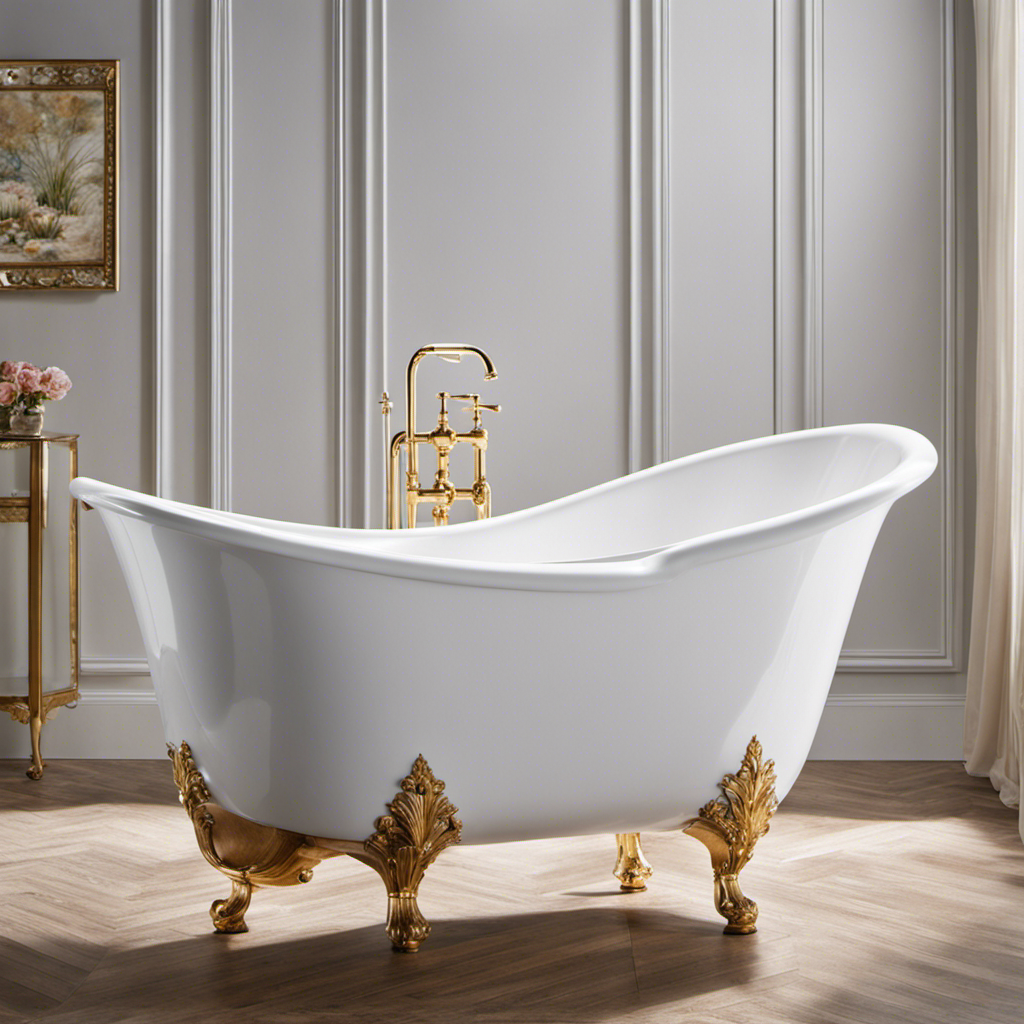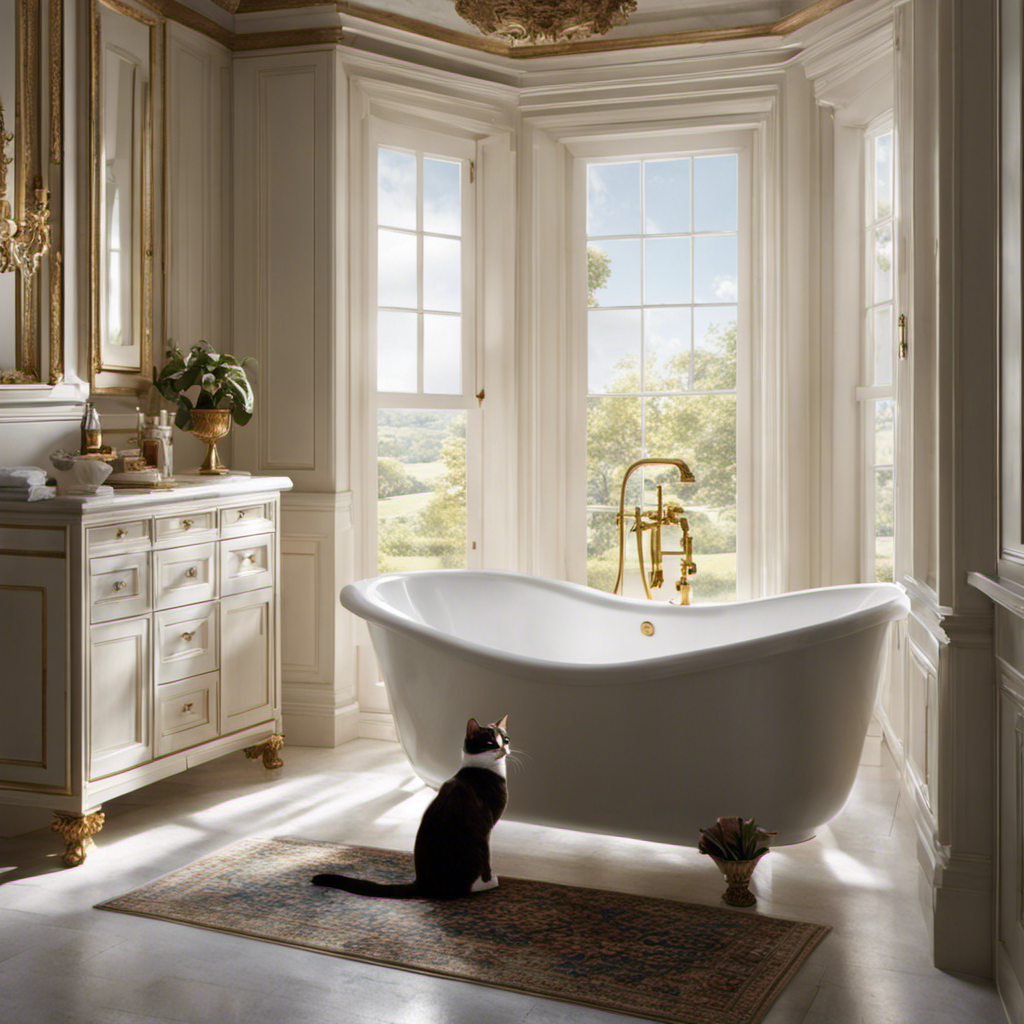Have you ever felt like your bathtub drain was as clogged as rush hour traffic? Well, fear not, because I’m here to help you unclog that drain full of hair.
In this step-by-step guide, I’ll show you how to gather the necessary tools, remove the drain cover, use a drain snake or wire hanger, try a homemade drain cleaner, and even use a plunger to dislodge the stubborn clog.
So grab your gloves and let’s get unclogging!
Key Takeaways
- Gather the necessary tools and preventive measures before starting the unclogging process, such as gloves, a drain snake, and a bucket.
- Use a screwdriver or pliers to remove the drain cover, or use a plunger to create suction and loosen a stuck drain cover.
- Use a drain snake or a wire hanger to effectively remove hair clogs from the bathtub drain.
- Consider using homemade drain cleaners like vinegar and baking soda or a salt and hot water solution to break down and dissolve clogs.
Gathering the Necessary Tools
Now, you’ll need a pair of gloves, a drain snake, and a bucket to gather the necessary tools for unclogging your bathtub drain.
Before we start, let’s explore some alternatives to a drain snake. If you don’t have one, you can try using a wire hanger, a bent metal coat hanger, or even a long, flexible plastic zip tie. These can all be effective in removing hair clogs from your drain.
Additionally, if you prefer natural solutions, you can use a combination of baking soda and vinegar or hot water and salt as natural drain cleaners. These can help break down the hair and unclog the drain.
Now that we have our tools ready, let’s move on to the next step of removing the drain cover.
Removing the Drain Cover
First, you’ll want to remove the drain cover to access the clog. Here are some alternatives to removing the drain cover:
- Use a screwdriver to unscrew the screws holding the drain cover in place.
- Look for a drain cover with a built-in removal tool, which can make the process easier.
- If the drain cover is stuck, try using a plunger to create suction and loosen it.
- Use a pair of pliers to grip the edges of the drain cover and twist it counterclockwise to remove.
- For older drains, you may need to pry the drain cover off using a flathead screwdriver.
Preventing hair clogs naturally can help reduce the need for removing drain covers frequently.
Transitioning to the subsequent section about using a drain snake or wire hanger to remove hair clogs, let’s now explore these effective methods.
Using a Drain Snake or Wire Hanger to Remove Hair Clogs
When it comes to dealing with hair clogs in drains, there are several effective methods and tools that can be used for removal. In this discussion, I will be focusing on two key points: effective hair clog removal methods and the tools that can be used to remove these clogs.
Effective Hair Clog Removal Methods
One effective way to remove hair clogs in a bathtub drain is by using a drain snake. This tool is designed to break up and remove the hair that has accumulated in the drain.
Here are some other methods that can help prevent and remove hair clogs in your bathtub drain:
- Use a hair catcher or drain strainer to prevent hair from going down the drain.
- Regularly clean the drain by removing any visible hair or debris.
- Pour boiling water down the drain to help dissolve any hair or soap buildup.
- Use a mixture of baking soda and vinegar to break down hair clogs naturally.
- Consider using enzymatic drain cleaners that are specifically designed to dissolve hair clogs.
Tools for Removing Clogs
To remove clogs in your bathtub, you can try using a plunger or a drain snake.
The first step is to ensure that there is enough water in the tub to cover the plunger’s suction cup.
Next, place the plunger over the drain and firmly push down to create a tight seal. Then, vigorously plunge up and down for about 20 seconds, applying force to dislodge the clog.
If this method doesn’t work, you can consider alternative drain snake options.
One option is a handheld drain snake, which is a flexible cable with a hook or barb at the end. Insert the snake into the drain and rotate the handle clockwise to snag the clog.
Another option is a power drain snake, which is a motorized device that can effectively break up and remove stubborn clogs.
Trying a Homemade Drain Cleaner
When it comes to unclogging drains, there are several homemade solutions that can be effective.
One popular option is to use a mixture of vinegar and baking soda. This combination creates a chemical reaction that helps break down clogs and clear the drain.
Another method is to use a mixture of salt and hot water, which can help dissolve grease and debris.
Vinegar and Baking Soda
Mix vinegar and baking soda together to create a fizzy solution that can help unclog your bathtub drain full of hair. This easy and effective method is a great alternative to harsh chemical drain cleaners. Here’s how to do it:
- Pour 1 cup of baking soda down the drain.
- Follow it with 1 cup of vinegar.
- Let the mixture sit for about 30 minutes.
- Boil a pot of water while waiting.
- After 30 minutes, carefully pour the boiling water down the drain to flush away the mixture and any loosened debris.
Using vinegar and baking soda is a natural, eco-friendly option for clearing clogged drains without resorting to harmful chemicals. However, if this method doesn’t work, don’t worry! There’s another simple and effective solution: salt and hot water.
Salt and Hot Water
Now that we’ve discussed using vinegar and baking soda to unclog a bathtub drain, let’s move on to another effective method: using a salt and hot water solution. This method is simple yet powerful, as it combines the natural cleaning properties of salt with the benefits of using hot water.
To create the salt and vinegar solution, follow these steps:
- Fill a pot with hot water, making sure it’s not boiling.
- Add a generous amount of salt to the hot water and stir until it dissolves completely.
- Slowly pour the salt and hot water solution down the drain.
- Let it sit for about 15 minutes to allow the salt to break down the clog.
- Finally, flush the drain with hot water to remove any remaining debris.
Using hot water in this process helps to melt and loosen the hair clog, making it easier for the salt to break it down. The heat also helps to dissolve any grease or soap residue that may be contributing to the clog. So, don’t underestimate the power of hot water when unclogging your bathtub drain!
Now, let’s take a look at the benefits of using hot water in this process:
| Benefits of using hot water | |
|---|---|
| 1. | Melts and loosens hair clogs |
| 2. | Dissolves grease and soap residue |
| 3. | Enhances the effectiveness of salt solution |
| 4. | Helps prevent future clogs by clearing any buildup |
Citric Acid Solution?
Using a citric acid solution is another effective method for clearing clogs in your bathtub. Citric acid has several benefits when it comes to drain cleaning. Here’s how you can use it:
- Start by pouring a cup of citric acid powder into a bowl.
- Add hot water to the powder and stir until it dissolves completely.
- Pour the citric acid solution down the clogged drain.
- Let it sit for about 30 minutes to allow the citric acid to break down the clog.
- Finally, flush the drain with hot water to clear any remaining debris.
Citric acid is a natural cleaner that is safe for both your pipes and the environment. It works by breaking down the hair and other organic matter, making it easier to remove. This method is a great alternative to harsh chemical drain cleaners and can help you maintain a clean and clog-free bathtub drain.
Using a Plunger to Dislodge the Clog
To easily remove the hair clog in your bathtub drain, start by grabbing a plunger and positioning it over the drain. Make sure the plunger completely covers the drain opening. Next, create a tight seal by pressing down firmly and then pulling up sharply. Repeat this plunging motion several times to create suction and dislodge the clog.
If the plunger method doesn’t work, there are alternative methods to consider. One option is using a drain snake, which can be inserted into the drain to manually remove the clog. Another option is to use a mixture of baking soda and vinegar, which creates a chemical reaction that helps break down the hair. However, these methods may not be as effective as using a plunger.
It’s important to note that while using a plunger is a relatively simple and cost-effective solution, it may not work for all types of clogs. In some cases, a more aggressive approach, such as using a chemical drain cleaner, may be necessary.
Transitioning into the next section, using a chemical drain cleaner should be considered as a last resort.
Using a Chemical Drain Cleaner as a Last Resort
If you’ve exhausted all other options, you might want to consider a chemical drain cleaner as a last resort for your stubborn clog. However, it’s important to be aware of the dangers associated with using chemical drain cleaners.
Here are some alternative drain cleaner options to consider:
-
Baking Soda and Vinegar: Mix equal parts baking soda and vinegar and pour it down the drain. Let it sit for about 30 minutes, then flush it with hot water.
-
Hot Water: Boil a pot of water and carefully pour it down the drain. The hot water can help dissolve the hair clog.
-
Enzyme Cleaners: These cleaners contain bacteria and enzymes that break down organic matter like hair. Follow the instructions on the product for best results.
-
Plumbing Snake: Use a plumbing snake to physically remove the hair clog from the drain.
-
Professional Help: If all else fails, it’s best to call a professional plumber to safely and effectively remove the clog.
While chemical drain cleaners can be effective, they also come with risks such as exposure to harmful chemicals and potential damage to your pipes. It’s important to explore safer alternatives before resorting to chemical drain cleaners.
Now, let’s talk about preventing future hair clogs with a drain strainer.
Preventing Future Hair Clogs With a Drain Strainer
After dealing with a stubborn clog in my bathtub drain, I realized that using a chemical drain cleaner should only be a last resort.
To prevent future hair clogs, I discovered the benefits of using a drain strainer. A drain strainer is a simple yet effective tool that helps catch hair and other debris before it enters the drain.
By installing a drain strainer, you can avoid the hassle of dealing with clogged drains and the need for harsh chemicals. There are various types of drain strainers available, including mesh strainers and silicone strainers.
Mesh strainers are affordable and easy to clean, while silicone strainers are more durable and flexible. Both types effectively prevent hair and other particles from clogging your drain, making them a worthwhile investment for any bathtub or shower.
Calling a Professional Plumber if All Else Fails
When dealing with persistent clogs that won’t budge, sometimes it’s best to call in a professional plumber. While there are DIY unclogging methods that can be effective in many cases, there are situations where a professional’s expertise is necessary.
Here are five reasons why calling a professional plumber is the right choice:
-
Experience: Plumbers have extensive experience dealing with all types of clogs and know the best techniques to tackle them.
-
Specialized Tools: Plumbers have access to specialized tools that can effectively remove stubborn clogs, such as drain snakes and hydro-jetting equipment.
-
Knowledge of Plumbing Systems: Plumbers understand the intricacies of plumbing systems and can identify underlying issues that may be causing the clogs.
-
Time-Saving: Hiring a professional plumber saves you time and effort, as they can quickly diagnose and resolve the problem.
-
Guarantee: Many professional plumbers offer a guarantee on their work, giving you peace of mind that the clog will be fully resolved.
Frequently Asked Questions
Can I Use the Same Drain Cleaner for My Bathtub as I Do for My Kitchen Sink?
No, you should not use the same drain cleaner for your bathtub and kitchen sink. Different types of drain cleaners are designed for different types of clogs. To prevent hair clogs, use a drain cover or regular cleaning.
How Often Should I Use a Drain Strainer to Prevent Hair Clogs?
To prevent hair clogs in shower drains, it’s important to use a drain strainer regularly. By doing so, you can catch the hair before it enters the drain, reducing the need for frequent unclogging.
Are There Any Risks or Dangers Associated With Using a Chemical Drain Cleaner?
There are risks associated with using chemical drain cleaners such as skin and eye irritation, as well as damage to pipes. Alternatives to chemical drain cleaners include using a drain snake or a mixture of baking soda and vinegar.
What Are the Signs That I Should Call a Professional Plumber Instead of Attempting to Unclog the Drain Myself?
When faced with a stubborn clog, signs that I should call a professional plumber include repeated clogs, slow draining, and foul odors. Hiring a professional ensures expertise, proper tools, and the benefit of avoiding potential damage.
Is It Possible to Damage the Drain Pipes or Plumbing System by Using a Wire Hanger or Drain Snake to Remove Hair Clogs?
Using a wire hanger or drain snake to remove hair clogs is generally safe and won’t damage drain pipes or the plumbing system. However, caution and avoiding excessive force are important to prevent any potential damage.
Conclusion
In conclusion, unclogging a bathtub drain full of hair can be a simple and straightforward process if you have the right tools and follow the necessary steps. By using a drain snake or wire hanger, a homemade drain cleaner, or a plunger, you can effectively remove hair clogs and restore proper drainage.
However, if all else fails, don’t hesitate to call a professional plumber for assistance. Remember, taking preventive measures such as using a drain strainer can help avoid future clogs.
For instance, Sarah, a busy working mom, successfully unclogged her bathtub drain using a drain snake and was relieved to see the water flowing freely again, allowing her to enjoy a relaxing bath after a long day.










